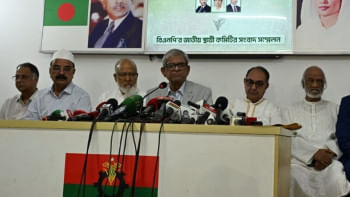The case of 'ghost' teachers and students

Whenever there is a discussion on the budget for education, it inevitably boils down to the amount of money allocated. In the proposed national budget for FY2018-19, the government has allocated 2 percent of the gross domestic product (GDP) for education (all levels), although the benchmark is 4 percent if the Sustainable Development Goals are to be achieved. Despite repeated calls from the development practitioners, the allocation has not increased till now.
The question that should be asked, how confident are we that an increased allocation will bring about the desired changes in improving the quality of our education? This is a question that has long been investigated by researchers, particularly in the USA. Research findings indicate that simply providing more funding is unlikely to improve student achievement. Money must be spent wisely to yield the desired benefit. Sometimes, some policy intervention is necessary to improve the productivity of the existing resource usages; in other words, preventing wastage of resources. So how is our education sector faring in this respect?
It is common knowledge that in Bangladesh, a big share of the pie (i.e. total allocated revenue budget for education) is spent on teacher salaries and fringe benefits—the size of the share is around 83 percent to 90 percent of the allocated budget for education. According to Bangladesh Bureau of Educational Information and Statistics (BANBEIS), there were 126,616 primary educational institutions in the country in 2016. These institutions, however, are not evenly concentrated. In some areas, there are multiple institutions located in close proximity while in other areas the situation is completely different. Some institutions have sufficient students while some have either insufficient students or none at all. There are 357,855 primary school teachers, 243,117 secondary school teachers, 9,727 intermediate college teachers, and 144,723 madrasa teachers at the pre-tertiary level in Bangladesh. Of them, a good number are on the payroll of the government.
In 2015-16, according to BANBEIS, 90 percent of the government's non-development spending went into paying salaries at the primary level, 90.31 percent at the junior secondary level, 87.83 percent at the upper secondary level, and 82.31 percent at the college level. Apart from the expenditures for public institutions, in 2016, the government spent Tk 115,066.63 million on salary subvention (otherwise known as Monthly Payment Order, or MPO) to non-government institutions. The size of public expenditure increases every year when new lists of non-government institutions come under the MPO scheme and/or nationalisation. It's very unfortunate that a large amount of the money is wasted because of teacher absenteeism, with teachers pocketing salaries and benefits but not turning up in the classroom. A survey conducted by the Campaign for Popular Education (CAMPE) in 2015 revealed that 11.3 to 12.7 percent of teachers were absent on the day of its visit to the government primary schools.
The situation is further aggravated by the "ghost" teachers—teachers who are paid salaries and benefits but do not exist in reality. As shocking as this may sound, this phenomenon is quite pervasive in non-government MPO-listed schools, mainly primary schools, colleges and madrasas. Recently, a private television channel broadcast a report that said there are 25 (private) intermediate colleges in the Uttara area and in many of them, there is none to teach. I am quite certain that while securing permission and affiliation from the relevant government department to run academic programmes, the colleges in question have shown their lists of teachers who existed only on paper. There is also the case of "ghost" students—students whose names are found on the school attendance book but who, like those ghost teachers, do no exist in reality. Lists of students are required to maintain eligibility condition for MPO. A colleague who has long worked with the Directorate of Audit and Inspection (DAI), Ministry of Education once described to me the conundrum of ghost students and teachers in non-government madrasas in a district. It was quite revealing.
Interestingly, there are also some ghost schools/colleges—makeshift schools/colleges sprung up for the purpose of listing in the MPO, which are not actually suitable to run academic activities.
So, it can be argued that the money being spent on education is not following a productive route; therefore, more money injected into the sector will hardly yield any positive result unless some much-needed policy reforms are undertaken. First of all, the causes of wastage should be investigated and due measures should be taken based on the findings. It is true that "inadequate budget" is a critical issue for the education sector of Bangladesh—be it at primary, secondary or higher levels—but the wastage issue is a critical one, too.
In order to increase the productivity of every penny spent, our policymakers should take initiatives to get rid of the "ghosts" at all levels. It requires a state-of-the art budgetary management technique to tackle the misuse of resources. It is possible by introducing public-private partnership in school management. Close-circuit television (CCTV) may be installed in the institutions so that education officers in charge of an area can monitor the existence and activities of teachers and students and their attendances from remote locations. Biometric attendance may be an alternative option, too. In many workplaces in Bangladesh, there is a biometric attendance system in place which is used to keep track of the attendance of the employees. Finally, measures should be taken to ensure accountability in public fund management.
Shamsul Arifeen Khan Mamun has a PhD in economics of education from the Beijing Normal University, China. He has been working at the Strategy and Policy Unit of the Higher Education Quality Enhancement Project (HEQEP) since 2016.
Email: [email protected]

 For all latest news, follow The Daily Star's Google News channel.
For all latest news, follow The Daily Star's Google News channel. 



Comments